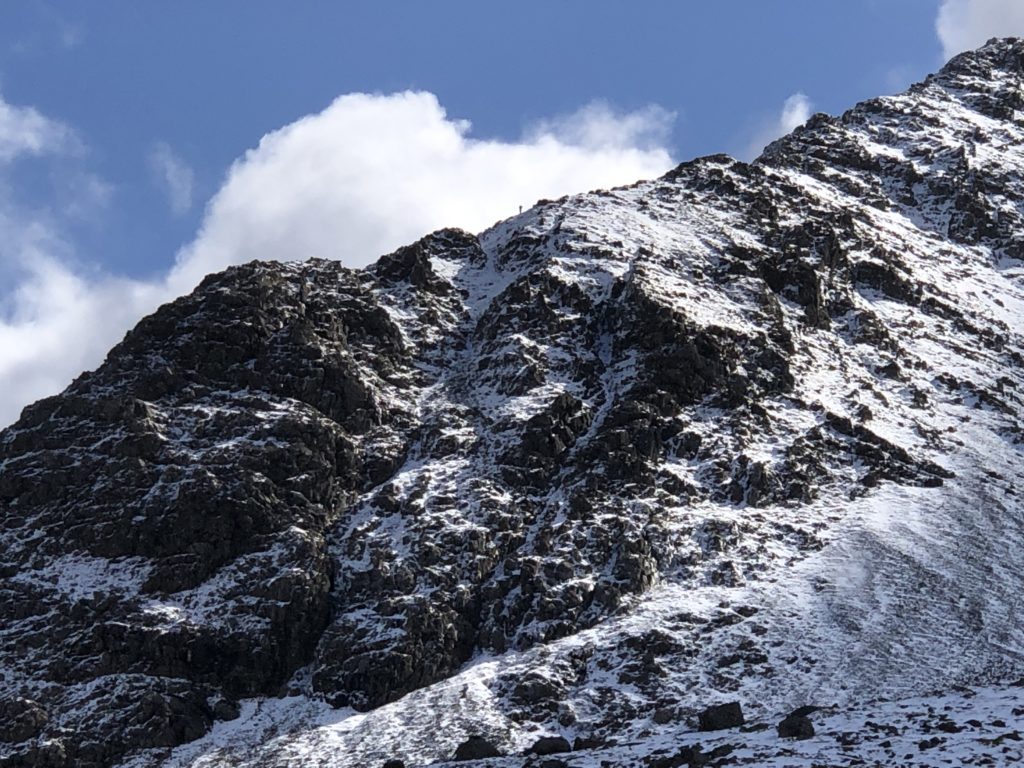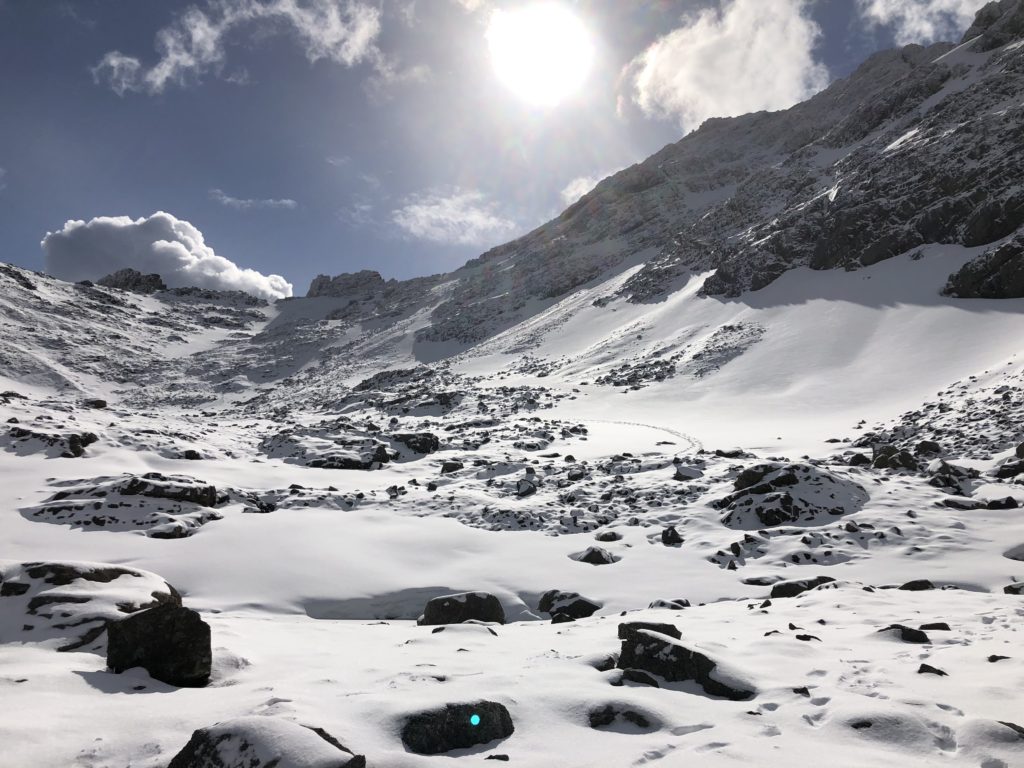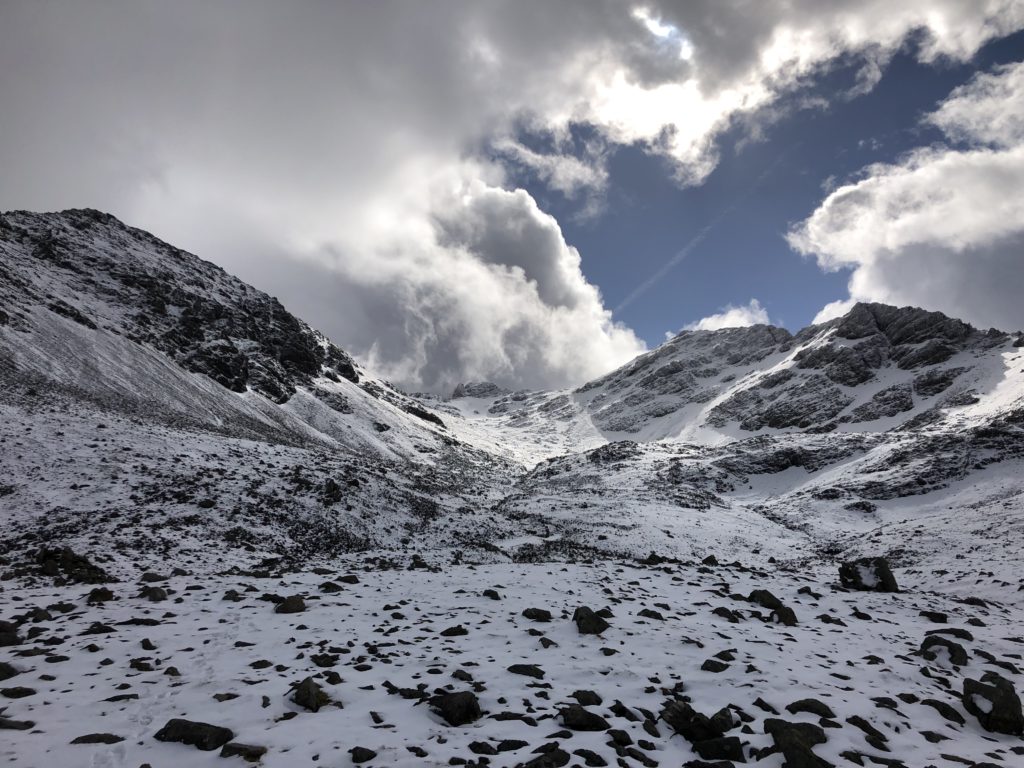Jamie Collinson takes in the corries, bogs and birds of Skye’s Cuillin Hills.

I knew things weren’t going to plan as the plane descended into Inverness. The tops of the hills were glazed over in a gleaming, icy looking snow. The phrase ‘winter conditions’ surfaced in my mind — I wasn’t prepared for those.
I’d been given a few days off from family life, and my cravings for the Highlands having peaked on reading Simon Ingram’s brilliant The Black Ridge, I booked a trip to Skye. My previous visits to the island had been all too brief, and Simon’s book made me see that it offered a wildness not easily found on the mainland. I’d understood that the Cuillin Hills — and their ridge — were Britain’s most serious mountains. I felt a keen urge to go and see them for myself.
So, on a Thursday morning in mid-April, I made my way through the welcoming folds of the Surrey Hills to Gatwick. (A few days after the trip, I encountered Elspeth Huxley’s description of the tamed English countryside as a ‘castrated leopard.’ That’s not quite fair, but Skye would illustrate her point.)
I picked up a hire car and set off for a first night in Portree, Skye’s largest settlement. The weather was bright and bruised all at once, in the way only the Highlands can offer. The peaks were snowbound, the rain threatening and occasionally spitting. I decided to listen to the audiobook of Tinker Tailor, for the umpteenth time, as I drove. If there is a greater pleasure than driving west through the Highlands, lost in the quickening, feverish tempo of that novel, I’m not sure I’ve found it.
I stayed for one night at the excellent Tongadale Hotel. (A sample Tripadvisor review: ‘When you enter the hotel you come straight into a bar. Literally a bar.’ My sort of place, I’d thought.) My primary goal for the trip had been to walk up Bruach na Frithe, one of the Cuillins’ several Munros, and the only one accessible to a lowly walker. In email exchanges with Simon, whom I’m lucky enough to have got to know a bit, he told me to think twice if there was ice in Fionn Choire, the gentle scoop out of the mountainside that forms the most commonly used route. I deferred the decision as to whether to try my luck until my second full day.
I’d come armed with birding books as well as walking ones, and I set off early for the Quiraing, the monumentally dramatic rock formations on the north of the island, which is known to be an excellent spot for raptors. I wound along the coast, watching vast patches of sunlight form, flicker and disappear on the blue-grey water. On my left was the Old Man of Storr, a looming column of rock standing watchfully on its ridge.
There was a large, slightly incongruous pay and display car park beside the Quiraing’s trailhead. I’d read that parking had been an issue here, and realized this must be its recent solution. There were two empty cars, and one containing a young woman, apparently on the phone. Almost unable to contain my excitement, I made haste and less speed getting my gear together, and finally set off into the cliffs. Again, the rain held off, and the cloud occasionally parted. Half a mile in I saw a man approaching me, and then a sea eagle, low, circling, coming directly overhead.
The man explained that his girlfriend had tired of the early starts and was waiting in the car. He was as full of enthusiasm as I was. “Seen the eagle?” I asked him, gesturing. He said he’d been looking for one the whole time, fumbled with his camera, looked briefly crestfallen as the bird rounded a cliff and disappeared.
Further on, I passed into the deep gorge between The Prison, The Table and The Needle, the fearsome rock formations whose names demand no further description. Another eagle was perched on a rock a long way off. Through my binoculars, I couldn’t tell if it was a second white-tailed or a golden.
I made the walk a loop and climbed steeply up a path that took me over the top of the formations and along their cliffs. I became briefly afraid, lost in cloud, that I’d walk over the edge. Coming down the other side, I saw that the car park was now full. There were lots of people in fashionable street clothes, waving selfie sticks and posing for pictures. As I left the carpark, I encountered a black Mercedes minibus whose masked, unsmiling driver aggressively flashed his lights and gestured at me to reverse to a passing place, even though he was closer to one. I was so angry I thought it might ruin the entire trip.
*
That afternoon I decided to walk out to Rubh’ an Dunain, the remote headland a few miles south of Glenbrittle. From here, I’d be far from other people, and if I was lucky, I’d get to see one of the best views of the black ridge itself.

The sun came out, the angry driver faded into memory, and I set off along the wide, rocky path. To my left, the Cuillins were indeed visible. Their ridge ran across the sky, rising up from the boggy grass into black rock and then pristine white, its flanks and corries vast, its upper edge savage. There were several burns running down from it, a couple with pretty waterfalls. At a ford, there was an option to use a bridge below the path. I’d decided not to bother just as a family worked their way up the slope towards me. There was a boy of twelve or thirteen among them. “Excuse me,” he called. “There’s a bridge!”
“Thanks,” I shouted back. “I know, I think it’s alright though.”
Having hopped across large stones to the other side, I sat down for a sandwich and looked back at the departing family. The boy distractedly toed a rock, looked up at his father to say something. I felt inexplicably sad for a moment. Something about watching them walk off, diminishing, into that huge landscape. The death of a moment. Something in the thwarted attempt to be helpful brought back the travails of being a teenage boy.
The sadness soon burned off. My lunch eaten, I set off again. The sunshine had gone, and I could see a storm approaching from behind, blasting out of Glen Brittle like smoke from a gun barrel. Sure enough, hail was soon thrumming over my clothing, and the world turned darker. The Cuillins disappeared, grey-white cloud sinking over them until you’d never have known they were there.
The storm passed over as I turned off the main path and headed for the ruins of the MacAskill settlement. Now there was no one and nothing. I felt a long way from anywhere. For a few minutes, I lost the path I was supposed to be on. I came to a boggy patch, settled on a firm looking spot on its other side, and leapt for it.
The next thing I knew, my left leg was hip deep in bog. Sadly, I’m not exaggerating. My binoculars landed softly in the smearing, black muck around me. I swore and pulled myself out. A rank smell came with me, and my leg and much else of me was covered in the stuff. Furious with myself, I removed my wallet and notes from my left pocket and secured them elsewhere. I was squelching when I walked, and my left leg was black and dripping. I swore, trying to decide how I’d salvage my only walking trousers.
I came across the ruins, and I stopped and got my breath back and cheered up a little. Just then, some very furtive looking birds flew in a tight little flock and landed fifty yards away. I raised my bins — the lenses, thankfully, were clean — and looked at them. There were five or six of them, and they looked like upright partridges, but I knew they weren’t. With the naked eye, they blended in so well that they were invisible. I watched them again, looked away again, and when I looked back they were gone.
There was a Neolithic chambered cairn, the remains of an Iron Age fort, and a lonely loch frequented by oystercatchers. I stood on the headland and looked out, breathing in the solitude before turning back.
Later, at the Old Inn in Carbost where I was staying the next two nights, I ordered a pint of Corncrake. ‘I wonder what a corncrake is,’ I thought to myself as I slumped down at my table. It was only then, looking them up, that I realized what I’d seen. Worth falling into a bog for, I decided, even when washing my trousers in the shower and removing the muck from my bins. The bottle of Talisker I bought at the distillery certainly improved my mood.
*
At breakfast the next day, I couldn’t help overhearing the trio of men sat close to me. One was young — in his early thirties perhaps. He seemed to know one of the older men, English like him, better than the third, who was Scottish. They deferred to the young man as to the day’s activity: The summit of Am Basteir, I think I heard, via the ridge and a chimney route.
“What will that involve?” the Scot asked, casually.
“A walk, a scramble on the ridge, two abseils and another walk,” the young man said.
Holy shit, I thought.
The woman who handled breakfast at the Inn asked each party what they had planned for the day, and she clearly knew her stuff. I told her I planned to have a look at Bruach na Frithe, but probably not to try and get to the summit. She seemed to think exploring the corrie beneath it was reasonable.
Parking up a mile or so from the Sligachan Hotel, one of the island’s best loved spots, I worked my way alongside a wide burn — the Allt Dearg – towards Glen Brittle. The forecast for my trip had been dreadful, but now the sun was out and was blazing. I can tell you I felt a very deep gratitude as the sweat broke out and the ache in my legs announced itself. The ridge reared up to my left, and gradually Fionn Choire — the corrie I wanted — was revealed. I turned off the path, climbed more steeply. Patches of ice and snow grew in size and frequency, and I remembered Simon’s words.

After I crossed the head of the burn I was in the corrie itself, and the ground was white over. There were perhaps four or five inches of snow. Cloud snagged and roiled over the summit of Am Basteir and the craggy outline of Sgurr a Fionn Choire, but the sun stayed out. My heart was beating faster, the mild edge of fear and the vast silence heightening everything. I looked up, clinging to rocks, and a golden eagle soared over the ridge above me, turned and disappeared again. I could hear my breath, and the little streams of meltwater churning over the rock.
If you don’t do anything you can’t undo, you’ll be alright, I thought, pushing on. The phrase ‘always a little further’ beat like a drum in my mind. I climbed to the back wall of the corrie, perhaps eighty yards from the ridge. I looked at it, tried to see a path beneath the Sgurr, which I’d need. But I’d lost the path a long time ago and couldn’t see another. It was steep here, the world beneath was seen as from an aeroplane. Reluctantly, I decided to turn back.
It was my mother’s birthday, and finding I had signal I made a video call to her from a flat rock. She and my sister told me I definitely must turn back.
“That’s the Black Ridge,” I said to my dad.
“It looks very white just now,” he said.
After the call, I sipped Talisker from my hipflask and felt happier than I had in some time. Being in that corrie was being in another world. The snow was easy underfoot. The crags beckoned. I’d seen an eagle against pristine blue and the sun was beaming down on me. I was nearly three thousand feet up, and there was nothing and everything. Since being up there, I’ve thought of it every hour and its power is barely diminished.
I trudged to the Sligachan, had a pint, and went back to the Inn for more. That night, the three climbers were sitting somewhat silently over their meals.
“I couldn’t help hearing you earlier,” I said. “I just wondered how you got on?”
“We had to turn back,” the young man said. He gestured over the table to the older man he seemed more familiar with. “Sore ankles.”
*
As I turned into Inverness airport the next day, Bill Haydon was unmasked for the umpteenth time, and I thought of the words in Simon’s book: ‘Some mountains possess. And slowly, this strange island’s mountains had possessed me.’